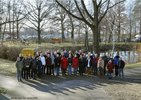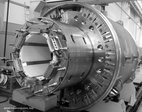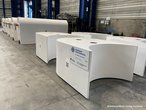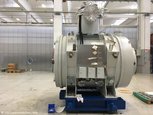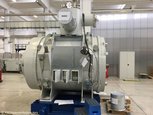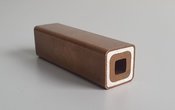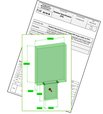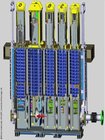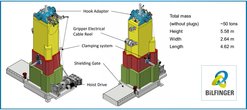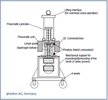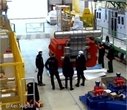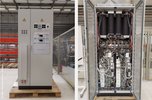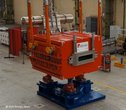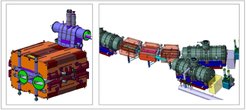
The Super-conducting FRagment Separator (Super-FRS) will be the most powerful in-flight separator in the world. Rare isotopes of all elements up to uranium will be produced at relativistic energies and spatially separated within a few hundred nanoseconds, enabling the study of very short-lived nuclei. The Super-FRS is the central device of the NUSTAR collaboration.
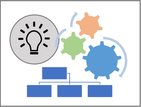
The realization of the Super-FRS machine is a sub-project of the FAIR international project. The sub-project Super-FRS has a defined scope (established by means of the Work Breakdown Structure), within defined time-planning and costs. Seven shareholder countries and several international companies are involved in the sub-project.
Super-FRS News
16.07.2021
Iron blocks for the later shielding in target area ready to be delivered
The production of iron blocks for the lateral shielding of the target area is finishing; the first blocks are being delivered to FAIR. The blocks of iron were manufactured by Walzengießerei Coswig (Germany). The foundry produced iron blocks for about 2,600 tons. The blocks of iron will surround the production target and the downstream components, dumping the radiation outside the target area.
12.07.2021
Successful Factory Acceptance Test of the second series superconducting short multiplet
The factory acceptance test of superconducting short multiplet SM-01 was successfully done on 21th and 22nd April 2021 and the corresponding documentation approved on the 12th of June. SM-01 is the second short multiplet of the series production. The sc short multiplets are produced by ASG Superconductors in La Spezia, Italy. The first-of-series short multiplet is already at the testing facility at CERN, where also the seven series short multiplets will be tested prior to their transportation to FAIR.
26.06.2021
SEM-Grids: Conceptual Design Review passed
The Conceptual Design Review of the beam profile detectors (SEM-Grids) was accepted. The detectors are based on the secondary electron emission (SEM) by wires technique. They are placed all along the Super-FRS beam line, and are used to measure the profile of the ion beams, i.e. transversal (horizontal and vertical) to the beam axis. The SEM-Grids are produced by the Helsinki Institute of Physics, Finland.
21.06.2021
Local Cryogenics Branch Box: Collaboration Contract signed
The collaboration contract for the production of Super-FRS Local Cryogenics components was signed between FAIR and the Budker Institute for Nuclear Physics, BINP, Novosibirsk, Russia. BINP is responsible for the design, manufacturing, pre-assembly and installation of the Branch Box and the corresponding Transfer Lines, and of the Warm Piping Lines of all Super-FRS branches. The Branch Box is a key component of the local cryogenic system, being the starting point of helium distribution to the three Super-FRS experimental branches.
06.06.2021
Quench detection and protection units: manufacturing contract awarded
The tender process for the manufacturing of the Super-FRS Quench Detection Units (QuD-U) is concluded. The tender was awarded to the company Semicon Sp. z o.o., Warszawa, Poland, which is charge to produce more than 200 pieces. The unit, fully designed at GSI, which also made and tested the prototypes, is composed of two separate printed circuit boards: an analog one, interfaced with the magnet, and a digital one, interfaced with the control system. The QuD-U will be integrated into the Super-FRS magnet power converters. The QuD-Units are a GSI contribution to FAIR.
26.05.2021
Successful Factory Acceptance Test of the first series superconducting short multiplet
The factory acceptance test of superconducting short multiplet SM-02 was successfully done on 19th and 20th March 2021 and the corresponding documentation approved on the 26th of May. SM-02 is part of the series production, which consists of seven short multiplets. The sc short multiplets are produced by ASG Superconductors in La Spezia, Italy. The first-of-series short multiplet is already at the testing facility at CERN, where also the seven series short multiplets will be tested prior to their transportation to FAIR.
05.05.2021
Contract signed for the production of mineral insulation cables for normal conducting magnets
The production contract for the MIC (mineral insulation) cables was signed with the company Hitachi Metals Europe GmbH. The cables will be part of the 5 normal conducting multipoles (3 octupoles and 2 sextupoles) which will be placed in the target area. Due to the highly radioactive environment generated by the production target, the magnets must be built with special radioactive resistant cables. A total of 3,360 meters cables will be produced.
01.05.2021
Quench Detection Units prototypes: production and testing campaign completed
Several prototypes of the FAIR Quench Detection Units (QuD-U), fully designed at GSI, were produced and tested between 2020 and early 2021. A QuD-U is composed of two separate printed circuit boards: the analog board QuD-A which acquires voltages from the superconducting magnets, provide high voltage insulation and quench trigger generation, and the digital board QuD-D which enables data acquisition, remote control of the QuD-A and communication with the control system. For the SFRS machine two QuD-A assembly, dedicated to quite different magnet types, were developed. All QuD-U will be integrated into the SFRS magnet power converters.The R&D on the QuD-U prototypes was necessary in order to start the purchasing process of series components.
20.04.2021
Target ladder: Detailed specifications approved
The detailed specifications of the target ladder are approved. The ladder can be moved upwards and downwards, orthogonally to the beam direction. In this way, various targets mounted on different levels of the ladder can be inserted in the beam line. The beams of radioactive isotopes will impinge on the target producing the nuclear reactions, which are of scientific interest. Since the target ladder is positioned in an area where a high radiation level is expected, the handling will be performed by a robot.
16.04.2021
Final Design Report of the target chamber finished
The Final Design Report of the target chamber was successfully concluded by KVI-Center for Advanced Radiation Technology (KVI-CART) of the University of Groningen, the Netherlands. The design was carried out in the frame of a collaboration contract with GSI. The target chamber is a large vacuum chamber, which houses the production target and beam diagnostics. Since the primary beam from SIS100 will imping on the production target with its maximum intensity, the chamber includes an iron shielding to reduce activation on the upper side of the chamber and allow hands-on maintenance. The tender for the manufacturing of the chamber will now start under the supervision of GSI.
16.04.2021
Preliminary Design Report of the shielding flask approved
The preliminary design report of the transport shielding flask was approved. The company Bilfinger Noell GmbH (BNG), Würzburg, Germany, is manufacturing the shielding flask for Super-FRS and p-bar. The shielding flask will transport highly radioactive material between the target area and the so-called "hot cell".
06.04.2021
Beam stoppers: manufacturing contract awarded
The production of two beam stoppers was awarded to Axilon AG, Germany. The Super-FRS beam stoppers are mechanical security devices able to intercept the ion beam. Beam stoppers are required to guarantee the personnel safety in the experimental areas during the beam delivery. The beam stopper must be used to stop the beam in an emergency case, e.g. when the safety system fails to dump the primary beam. By means of a pneumatic driven actuator on an installation flange, the stoppers are moved down and placed transversally to the beam.
04.02.2021
Detailed specifications of Beam Loss Monitor approved
The detailed specifications of the Beam Loss Monitor (BLM) detectors are approved. The BLMs will provide information on beam presence or loss at the position where they are mounted. They will be mounted close to place where beam loss is expected like slits, targets or degraders. The Super-FRS will be using eight Beam Loss Monitors along the beam line.
04.02.2021
First-of-Series superconducting dipole type-3 delivered at its testing station at CERN
The FoS superconducting dipole of type-3 was delivered at the testing station at CERN. The magnet was produced by the company Elytt, Bilbao, Spain. The tesing station at CERN was built under the frame of a collaboration agreement with CERN and GSI. Currently, the superconducting long mutliplet (embedding one large quadrupole, three sextupoles, two short quadrupoles, two embedded octupoles, one steerer) is beeing tested. The superconducting dipole is now under check in the so-called preparation area. Its test will start in a few weeks.
18.01.2021
Power Converter prototype delivered at FAIR
After the successfull Factory Acceptance Test, the prototype of the power converter type FR.Q4 was delivered to FAIR. The power converter FR.Q4 will be used to power the Super-FRS superconducting dipoles and quadrupoles. The prototype was built by the company Jäger, Germany. After the in-house site acceptence test (SAT), the protype will be used as patter for the production of series power converters.
13.01.2021
Factory Acceptance Test of first iron block for shielding in target area and start of series production
With the successfull Factory Acceptance Test (FAT) of the first block of iron, the company Walzengießerei Coswig (Germany) is starting the series production. The foundry will produce iron blocks for about 2,600 tons. The iron blocks are the most relevant component of the lateral shielding in target area. They will surround the production target and the downstream magnets and components dumping the radiation outside the target area.
12.01.2021
Detailed specifications approved for local cryogenics components
The detailed specifications of all components of the Local Cryogenics system are approved. Supplied by the FAIR cryogenic system, the Super-FRS Local Cryogenics system will distribute and feed cold helium to the 63 Super-FRS magnet cryostats. The system consists of dipole feed-boxes, multiplet feed-boxes, end boxes, a large valve box (called branch box) which connects braches with pre-cooler, transfer lines, jumper connections, multi-purpose cold-warm return line, plus all the corresponding safety valves, instrumentation set-ups, and control-system hardware.
11.01.2021
Factory Acceptance Test of the First-of-Series superconducting dipole type-3
The FAT of the FoS superconducting dipole of type-3 was concluded successfully at the production company Elytt, Bilbao, Spain. Elytt is manufacturing a total of 24 superconducting dipoles for the Super-FRS. The dipoles are clasisified into three groups: the standard dipoles of Type-3 (9,75° bending angle), the standard dipoles of Type-2 (11° bending angle), and the branched dipoles with a special Y-form, allowing two possible bendings. The latter magnets are located at the branching points, where the beam line forks into two branches.
14.12.2020
Final Design Report of the superconducting branching dipoles approved
The FDR of the superconducting branching dipoles was approved. The branched dipoles are located at the branching points, where the beam line splits into two lines (branches). They have a special Y-form, allowing two possible bendings. For this reason, the sc branched dipoles required a special design.The design and production of the sc dipoles is done by the Spanish company Elytt in Bilbao.
07.12.2020
Shielding flask tender: manufacturing contract awarded
The tender for the production of the shielding flask was closed. The company Bilfinger Noell GmbH (BNG), Würzburg, Germany, was awarded for the manufacturing of this big component. Purpose of the shielding flask is the transport of highly radioactive material between the target area and the so-called "hot cell". The flask is equipped by a carrying frame and a winch that pulls it through a shaft of a length of about 8m. The wall thickness of the flask is designed in a way that at surface the maximum dose rate is below 100 µSv/h. The total weight is about 25 t.
02.11.2020
OK for series production of superconducting long multiplets
The issue of a bank guarantee ratified the start of series production of superconducting long multiplets (see related article, in Italian). The company ASG Superconductors S.p.A., Genoa, Italy, is in charge for the manufacturing of 32 superconducting multiplets, among which 8 short multiplets (already in production) and 24 long multiplets. A multiplet is a group of several magnets embedded in a unique vessel. A long multiple will host up to 9 magnets, with a length of 7 meters, an high of 4,3 meters and a weight of 60 tons.
16.10.2020
Final Design Report for lateral iron shielding in target area
The Final Design Report for the production of lateral iron shielding in target area is accepted. The blocks of iron are going to be manufactured by the company Walzengießerei Coswig (Germany). The foundry will produce iron blocks for about 2,600 tons. The blocks of iron will surround the production target and the downstream magnets and components dumping the radiation outside the target area.





